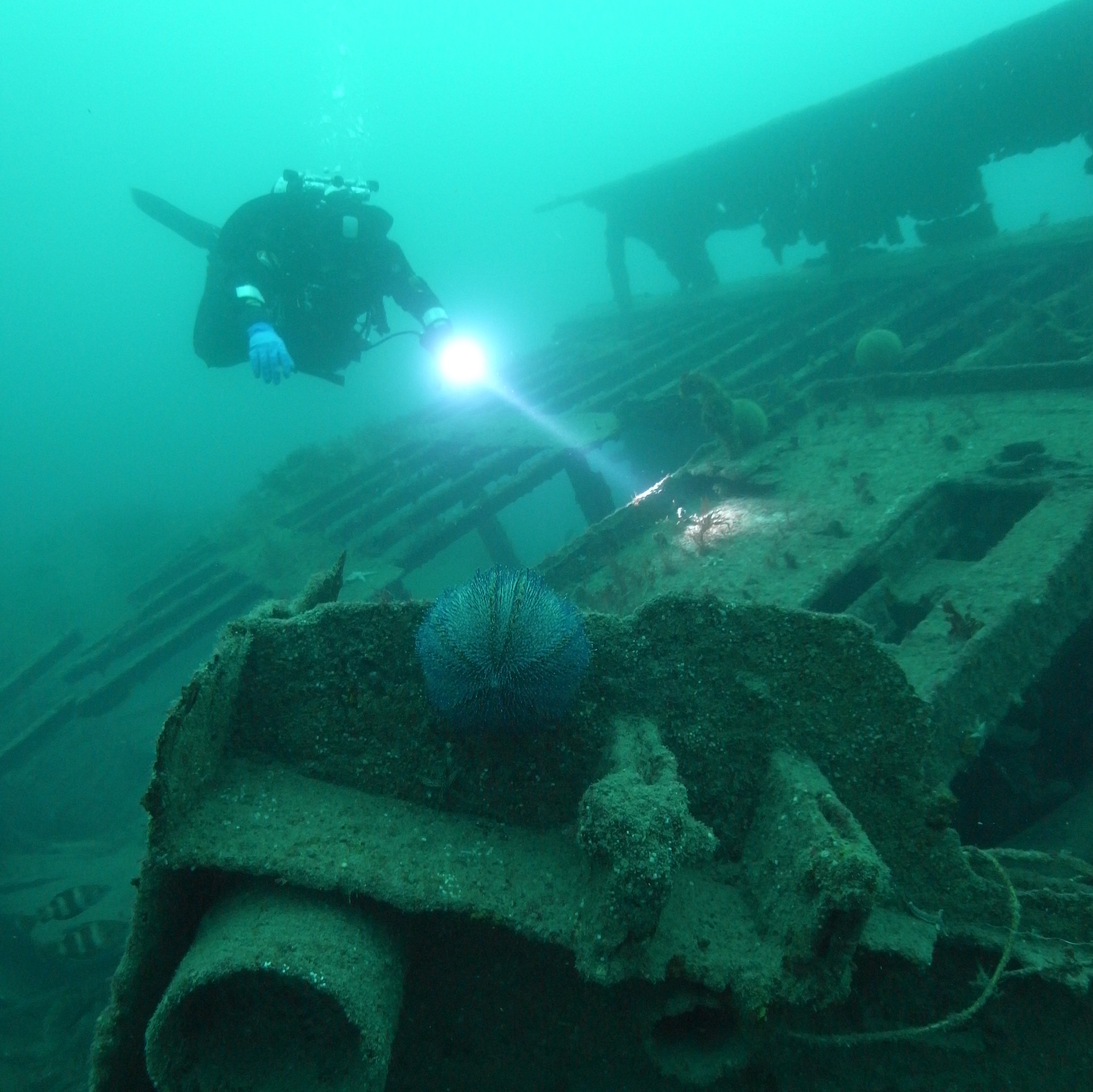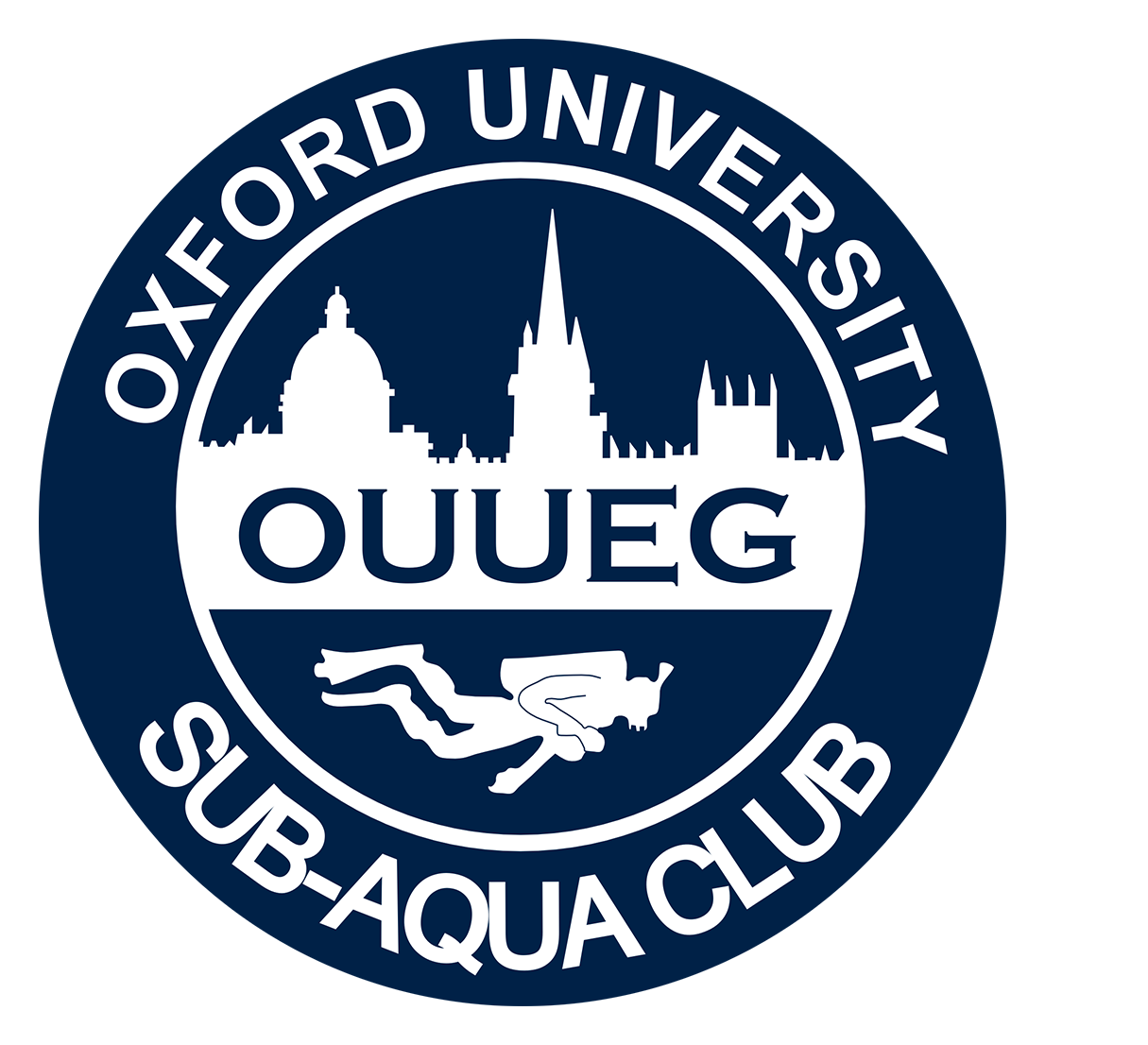Diving Plymouth wrecks, 7-9th September 2012

Divers: Grainne (co-ordinator), Tom, Giles, Penny and Nick
Sadly there has been very little in the way of diving this summer on account of the weather. So when clear skies and highs of 250C arrived in the UK, we were fortunate that someone still remembered what scuba diving was and took advantage of the situation (thanks Grainne). As the notification was at the 11th hour, there were relatively few of us on this trip; four OUUEG regulars and me (Nick), a less frequent but nonetheless enthusiastic diver.
We met at the Club hut (with Grainne being picked up on the way) to arrange kit and transport and once everyone was ready we set off into the night. Fortunately the roads to Plymouth were clear and with everyone spurred on by the prospect of a weekend of diving, we made good time arriving in Ivybridge at about 23:00 (roughly 4 hours from Oxford to Ivybridge). After planning Saturday’s dives with the aid of a round or three from the Ivybridge local, we drove the short distance (drivers limited themselves at the pub!) to the lodgings.
Accommodation
Harford bunkhouse, Ivybridge (http://www.ldwa.org.uk/ldp/members/show_location.php?supplier_id=1875)
Even if the weather had turned and ruined the diving (it didn’t), staying at this bunkhouse would have made the trip worthwhile. A diamond in the rough of ‘rough’, budget accommodation, the Harford bunkhouse at Ivybridge was luxurious. Several comfortable dorms, 2 shower rooms (some with hot water) and 2 kitchens (with cutlery/crockery) were ours for £14/person/night. Moreover, we were lucky that the bunkhouse was otherwise empty and so, Tom’s snoring and some noisy peacocks aside, we had very peaceful nights (something I imagine distinguishes this trip from others). In summary, I would heartily recommend the Harford bunkhouse to anyone looking to spend some time in Dartmoor National Park or diving in Plymouth/Salcombe/Torquay.
Day 1
HMS Abelard (morning)
Depth – 14m; Visibility on the day – 5-6m; Current on the day – minimal
Wrecked on Christmas Eve 1916, the HMS Abelard is an old steam trawler that was converted into a mine sweeper. Sadly it fell afoul of a mine and went down. The most striking part of her that remains is the boiler that stands about 3m high off the sea bed. However, with some attention to detail, it is possible to identify parts of the remainder, including the hull, which leads off to the south.
James Eagan Layne (afternoon)
Depth – 25m; Visibility on the day – 3-4m; Current on the day – minimal
A large cargo ship built in the US to supply the UK during WW2, the JEL was hit by a torpedo from a German U-boat near Eddystone reef (11 miles offshore). She suffered considerable damage but was towed into Whitsand Bay to save as much of her cargo as possible. It was here that she finally sank. Fortunately, all of her crew survived. For more information go tohttp://www.promare.co.uk/liberty70/index.htm
Events
After the traditional bacon butties (ably fried by bacon butty officer Giles), we were suitably refreshed and drove the short distance to Plymouth. The drive takes about ½ an hour from Ivybridge but we had to stop off along the way to pick up equipment for the boat from Pete (who borrows the RIB from OUUEG and kindly helps maintain the boat). So by the time we had faffed around onshore setting up, we cast off a bit later than anticipated. Unfortunately, one of the tanks was unexpectedly empty and so we were further delayed by a quick trip to Fort Bovisand for an airfill. All this meant that it was about midday by the time we made it to our first dive site, HMS Abelard.
We (Giles and Tom) prepared a ‘reverse lazy shot’ (a new term for me) – something they were both particularly proud of when it worked as the tide went out – and we were ready to go. As I had not dived with the club before and had not dived for several months, the HMS Abelard was a dive to help re-introduce me to the underwater world. At a depth of 10-15m and in a relatively sheltered location, it is perfectly suited for divers looking to get back into the swing of things. The first wave of divers included Tom, Giles and me. Tom and I spent the first ¼ of an hour going through some of the basic underwater skills as I was bit rusty, before joining Giles to explore the wreck. Although not the most exciting of dive sites, there was enough to keep us occupied underwater for close to an hour. Next in were Penny and Grainne but Abelard could only hold their interest for about 40 mins, so it was not long before we made the short trip back to Bovisand for feeding and filling. Lunch was a feast, especially for those who had yet to try a banana sandwich (the cheese being left forlornly in the fridge).
With lunch soon over, we arrived at the JEL mid afternoon and Tom and Giles were first in. In the meantime, Grainne talked Penny and I through the basic handing of the boat and let us take her for a quick spin. However, it was long before we were kitting up and heading down to the wreck ourselves. Starting at the bow we made our way round the wreck marvelling at the immensity of it. Sadly, the visibility was less than we would have liked but it was enough for me (new to the JEL) to appreciate her. After about 30 mins of diving we began our ascent. Fortunately, it was unhindered although Tom and Giles had tried to send a crab down the DSMB. But it was too smart and made a bid for freedom long before Penny reeled it into our midst.
Tired after a long day diving, the faff took a little longer than usual and so it was not until about 22:00 that we made it back to the bunkhouse (having stopped off at Tesco on the way). However, when we tucked into Grainne’s delicious chilli con carne (with butter beans not kidney beans), we were so revived that the hour almost felt civilised. Several helpings (and a chocolate tart) later, we made for bed eagerly anticipating what Sunday held in store.
Day 2
SS Persier (morning)
Depth – 30m; Visibility 6-8m; Current – minimal
The Persier, originally built in 1918 as the War Buffalo, was a World War British Standard B class ship and saw action at Dunkirk. She acted as a transport vessel for equipment and men throughout the war. After setting sail from Cardiff, she found herself off Eddystone reef on 11th February 1945 carrying 60 or so passengers, when she was hit by a German torpedo. The Captain stopped the engines and ordered the ship to be abandoned, as the holds were flooded. Passengers fled into the lifeboats and clustered around the stern. Sadly at this point a defective steam valve is thought to have restarted the engines and the lifeboats and passengers were cut to pieces by the propeller. The escort vessels sent out to help were able to rescue some of the crew and the Persier was left steaming towards the shore. When morning came, she was nowhere to be found and was listed as torpedoed and sunk off Eddystone. She was rediscovered is 1969 in Bigbury Bay.
Events
We had hoped to make it to Eddystone reef on Sunday morning but the wind was against us. So, with the recommendation of Discovery Divers, we made for SS Persier (a 45 minute drive away). After 15m minutes of trying to locate the wreck and recovering some mooring rope, Tom, Penny and I were the first in. The descent was smooth and the first thing that loomed into view was the hull of the ship, inhabited by a large, grumpy conger eel. In spite of Penny’s encouragement, Tom and I were less inclined to get up close and personal with it. The rest of the dive was spent exploring the remainder of the wreck, which was teeming with life. Forests of seaweed covering the wreck were inhabited by wrasse, pollack and other fish and more conger eels and lobsters were spotted hiding in the midship. The dive, the most spectacular of the weekend, was soon over – sadly 25 minutes was the no deco limit – but everyone was enthusiastic to return next time. This was echoed by Giles and Grainne, the last wave to go, with Grainne displaying her appreciation of the site during the ascent (little did she know Giles was filming her all the while).
By the time were had made it back to Bovisand and recovered it was nearly 16:00, so we decided to call it a day. After a bit of faff, we left Mount Batten about 18:00, returned the kit to Pete and (with some lightening quick driving for which Tom is infamous) made it back to Oxford before 22:00!
All in all a great weekend – thanks for Tom, Giles, Penny and Grainne (esp for organising) for making it so. I only wish I had started diving with OUUEG earlier!
 OUUEG — Oxford University Underwater Exploration Group
OUUEG — Oxford University Underwater Exploration Group